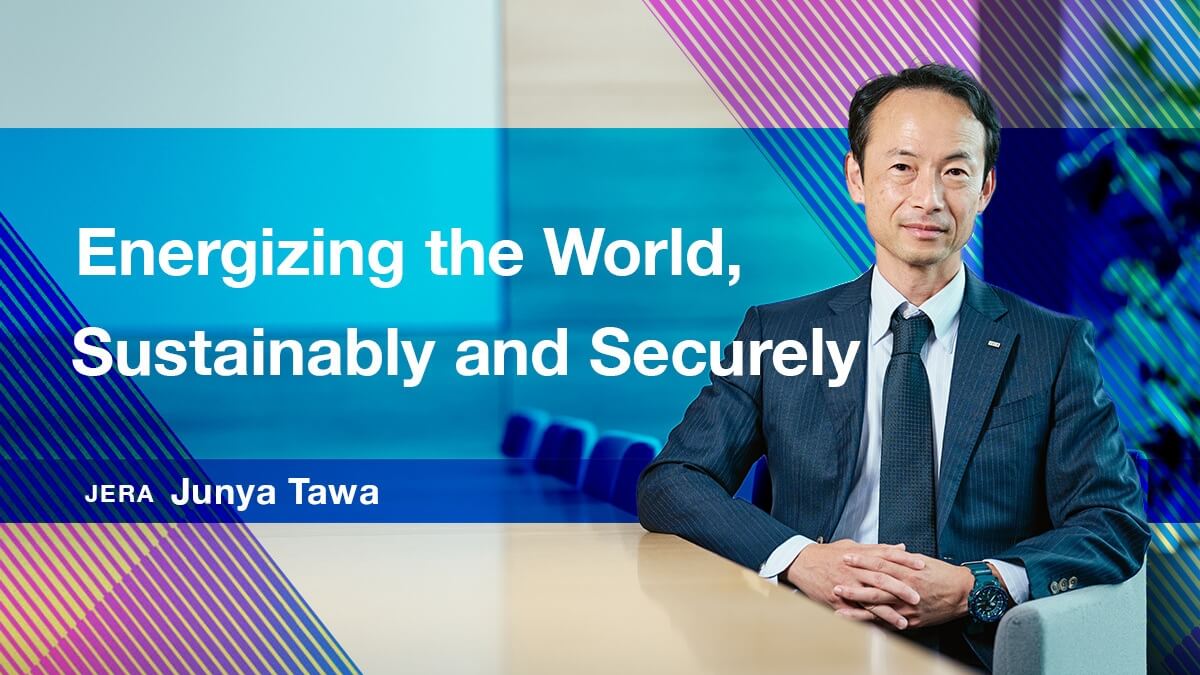
Powering Toward a Global Decarbonized Future by Embracing Innovation
5 July 2024
Energizing the World, Sustainably and Securely
At this point there is little doubt that reducing carbon emissions is the greatest challenge facing humanity. There is also little sense in underestimating the scale and complexity of the task ahead. Multipronged approaches are required, recognizing that diverse solutions are vital for different industries, countries and regions. Against this background, Japan’s largest power generation company, JERA, is laying out a bold vision to tackle these crucial issues both at home and internationally.
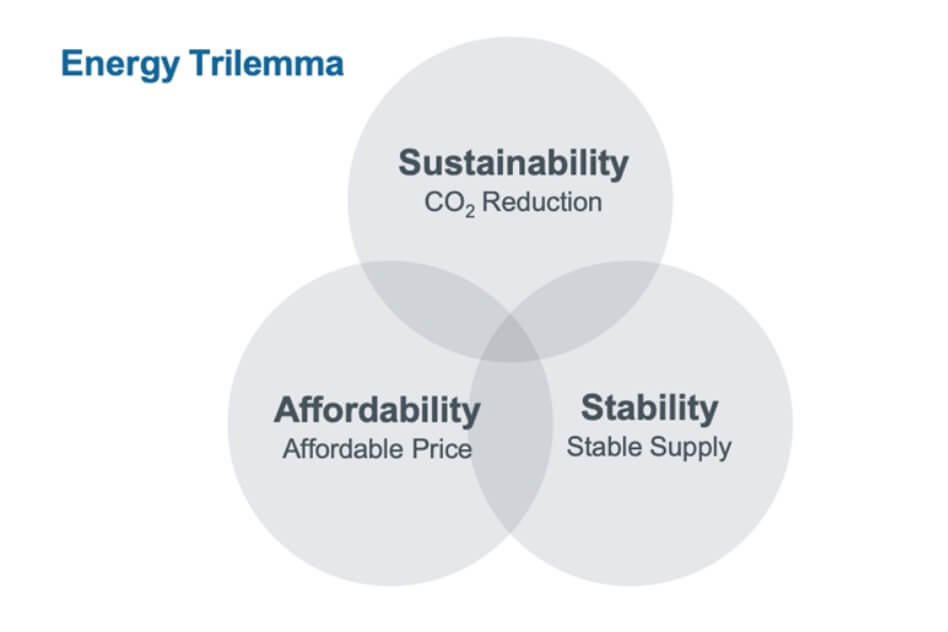
What has come to be called the “energy trilemma” illuminates the core challenges, and frictions, for the transition to decarbonized energy and economic systems. Comprised of Sustainability, cleaner power generation; Affordability, delivering it at a reasonable cost; and Stability, guaranteeing a reliable supply; the trilemma comes in balancing these sometimes-conflicting interests.
Events such as the invasion of Ukraine and the ongoing geopolitical tensions casting shadows around the globe have only served to underline the potential risks in the energy sector.
A Bold Vision
Addressing this multitude of issues head-on, on May 16, JERA announced its “JERA Growth Strategy to Realize the 2035 Vision,” a plan to drive the company forward in its quest for diversified cutting-edge energy solutions on the way to fulfilling its commitment to achieve zero CO2 emissions by 2050.
At the center of JERA’s strategy are its own unique triumvirates: three core business areas and a trio of specialized organizational capabilities. Investment will focus on LNG (liquefied natural gas), renewables, and hydrogen/ammonia as “Strategic Positioning.” At the same time, JERA will continue to bolster its operational capabilities in business development, optimization, and O&M (operations and maintenance). This synergy will deliver a range of innovative and diverse solutions suited to the geographic and economic needs of each customer, region, and country in a way that only JERA is positioned to do.
JERA's vision for 2035 is to “scale up its clean energy platform of renewables and low greenhouse gas thermal power, sparking sustainable development in Asia and around the world.” To make this a reality, JERA plans to invest a total of 5 trillion yen (approximately $32 billion at current rates) in the three strategic business areas by 2035, and is aiming for net income of 350 billion yen (approx. $2.24 billion).
Natural Advantages
During the decarbonization shift, thermal power generation is going to remain a significant element of the energy mix in order to balance supply and demand while grappling with the trilemma. LNG, which emits around half the CO₂ of coal, is both a core division for JERA and a sector in which it is a global leader.
The first strategic business area is LNG. The key for LNG business is maintaining the supply.
“We are engaged in LNG distribution and trading around the world 24 hours a day, 365 days a year, with staff all over the world, including Europe, and Singapore,” says Junya Tawa, the company’s chief strategy officer.
Leveraging its involvement in the entire supply chain allows JERA to maintain a stable and competitive supply of LNG, explains Tawa.
Another strategic business area is renewables, centered on solar and wind power. Offshore wind has enormous potential and JERA is already involved in major projects from the north of Japan to Taiwan and on to Norway.
“We are in a very unique position, especially in the field of offshore wind power, and I think that we are probably the only company in Asia, except for Chinese players, that already has a large-scale offshore wind power plant in operation,” says Tawa.
Reinforcing its commitment to the sector, JERA followed the 2023 acquisition of Belgian offshore wind specialist Parkwind with the establishment of JERA Nex in April in London to take the company’s global renewables portfolio to the next level. JERA is now aiming to expand its renewables capacity to 20 GW by 2035. By combining Parkwind's knowhow and capabilities with JERA’s experience in developing projects in Asia, the goal is nothing short of being a “game changer” and a global player in the renewables field.
Ammonia and hydrogen comprise the final strategic business area. JERA is aiming to convert thermal power stations from LNG and coal to hydrogen and ammonia, which do not emit CO2 when burned. Part of this will be the retrofitting of existing coal plants, and JERA began a large-scale demonstration test in April 2024 at a commercial power station substituting 20% of its coal fuel for ammonia. There have been concerns about the production of nitrogen oxides when ammonia is burned, but the trial has demonstrated that conversion is possible without increasing such emissions.
Although there is a tendency to focus on ammonia as a fuel, it is actually vital as the key to a hydrogen society.
“We are keenly aware that coal-fired power is decarbonization’s biggest challenge,” says Tawa. “In terms of existing coal power stations, inefficient ones will be phased out, and those that are both essential to electricity supplies and highly efficient will be converted to 100% ammonia. This will open the door to a hydrogen society and promote its use in other industries. Ammonia is not a life-extension measure for coal-fired power.”
JERA is working to increase the utilization of hydrogen and ammonia, beginning with expanding the amount converted for use as a fuel. But the “the biggest challenge” is to “build a new supply chain,” notes Tawa.
Although already also used for fertilizer, the existing global market for ammonia is relatively small scale. JERA is currently in discussions with an American company on an ammonia production project, and is also looking at potential expansion in the Middle East and Australia in the future. Tawa points out that JERA is able to handle everything, end-to-end in this promising sector.
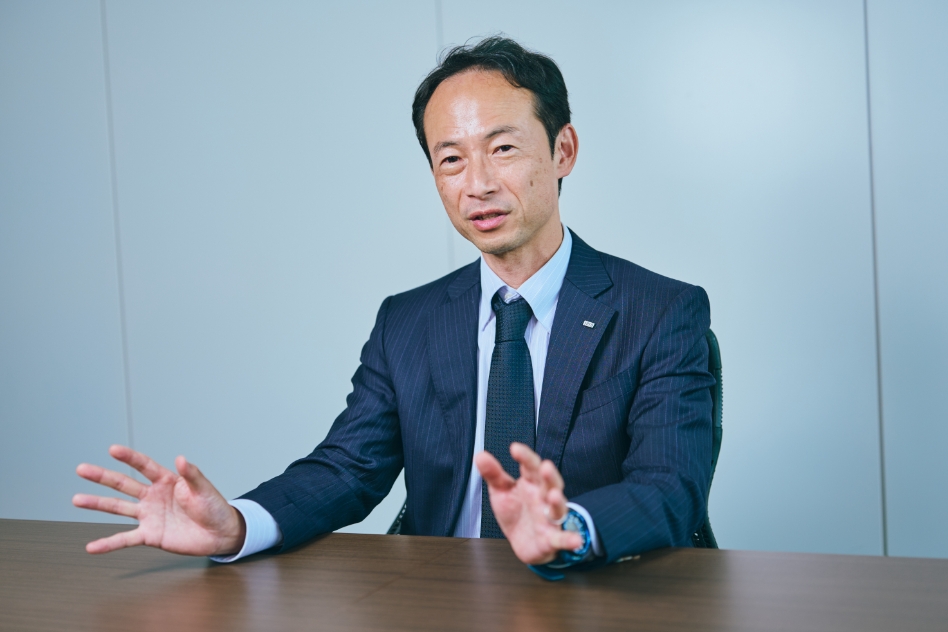
Cap)Junya Tawa/JERA Co., Inc. Chief Strategy Officer (CSO) and Head of the Planning Division.
A Winning Triad
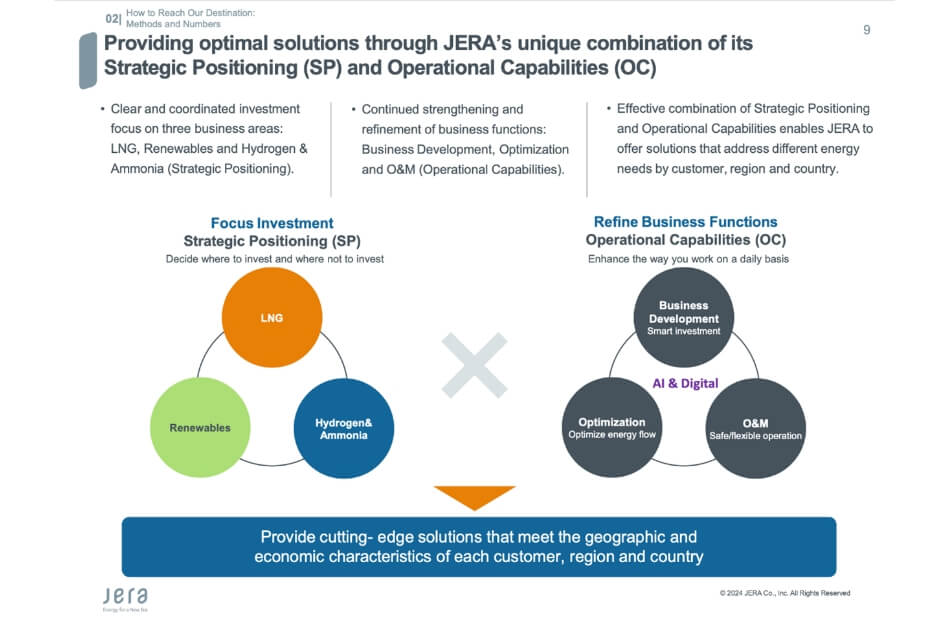
To maximally and flexibly grow and manage these three business areas, JERA will continue to hone its three capabilities: Business Development, Optimization and O&M (operation and maintenance).
Tawa likens the project managers in business development to investment bankers and the optimization experts to traders, while engineers are responsible for actually keeping the power running through O&M. “We are aiming to make JERA a company in which these three completely different types of professional (investment bankers, traders, and engineers) work seamlessly together and consistently bolster their expertise. This is a very unique situation compared to other electric power companies,” he adds.
Much More to Come
Leveraging this structure, JERA will provide cutting-edge solutions tailored to the unique situation of each country or region by utilizing its three global-scale specialist business groups.
JERA's Vision 2035 positions it as a global energy transition leader while balancing sustainability, affordability, and stability. By combining its expertise in traditional, next generation and renewable energy sources, JERA is set to play a central role in shaping a decarbonized world.
RELATED STORIES

Challenging the Skepticism of Green Countries: The Reality of Ammonia as a Fuel Source
A variety of solutions to combat global climate change are being pursued around the world.
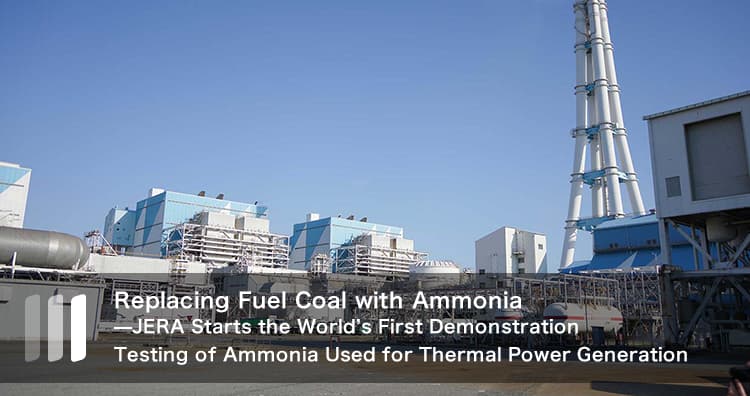
Replacing Fuel Coal with Ammonia—JERA Starts the World’s First Demonstration Testing of Ammonia Used for Thermal Power Generation


